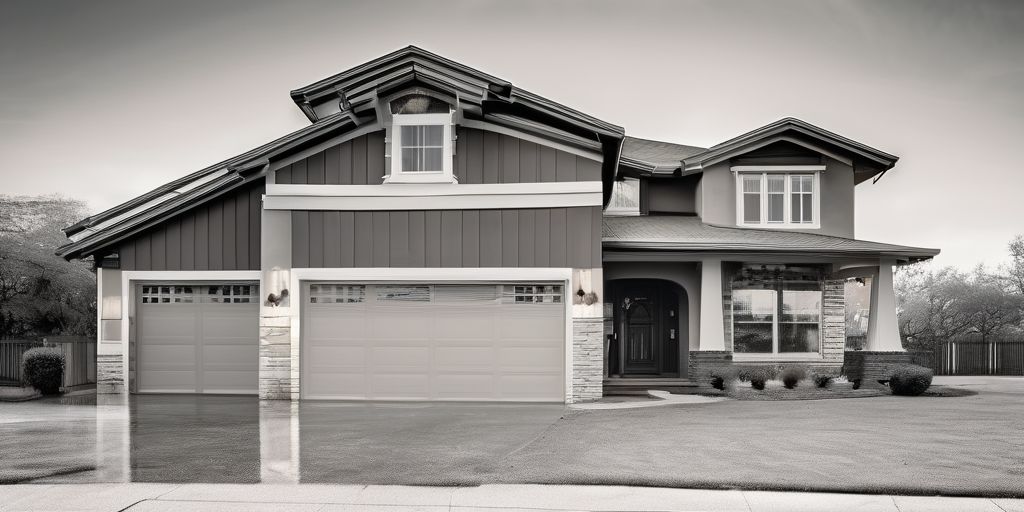Mastering the art of spray painting window frames can transform the look of any home in Kitchener-Waterloo. This guide provides a comprehensive approach to achieving professional-quality results, from the initial preparations to advanced techniques and maintenance. Whether you’re a DIY enthusiast or a seasoned painter, these insights will help you enhance the durability and aesthetic appeal of your window frames.
Key Takeaways
- Proper preparation involves understanding spray painting basics, selecting a dust-free, well-ventilated environment, and adhering to safety precautions.
- The spray painting process requires testing the paint, applying thin and even coats, and allowing sufficient drying time between layers.
- Advanced techniques such as glazing can add depth and enrich colors, but require planning as each layer darkens the surface.
- Maintaining spray-painted window frames includes regular cleaning, touch-ups, and protection from UV rays and humidity to prolong their life.
- Using professional-grade materials and tools, such as high-quality fixatives and varnishes, will ensure a superior and lasting finish.
Preparing to Spray Paint Window Frames
Understanding the Basics of Spray Painting
Spray painting window frames requires a methodical approach to ensure a smooth and lasting finish. Proper preparation is the cornerstone of a successful spray paint job. Before you begin, it’s crucial to understand the basic principles:
- Always read the label directions carefully before using the spray paint.
- Conduct a test spray on a separate piece of paper to gauge the paint’s behavior.
- Maintain a distance of 15-18 inches between the spray can and the window frame.
- Apply the paint in short bursts to achieve thin, even layers, allowing each layer to dry for at least 30 minutes.
Selecting the right environment is also vital. A clean, well-ventilated area is ideal, preferably with a humidity level below 65% and a temperature between 55-60F. If the conditions are not suitable, it’s best to wait for a better day or adjust your workspace accordingly.
When applying multiple coats, change the direction with each new layer to ensure even coverage across the entire surface.
Remember, the goal is to achieve a durable and attractive finish without the need for frequent touch-ups. By combining spray and brush techniques, you can maximize the efficiency and quality of your work, ensuring that your window frames stand out with a professional look.
Selecting the Right Environment
When it comes to spray painting window frames, selecting the right environment is crucial for achieving a flawless finish. The environment affects the paint’s drying time, consistency, and overall quality. Here are some key factors to consider:
- Temperature and Humidity: Ideal conditions are a moderate temperature and low humidity. Extreme temperatures can cause the paint to dry too quickly or too slowly, while high humidity can lead to a tacky finish.
- Wind and Dust: A calm day is preferable. Wind can blow dust and debris onto wet paint, marring the surface.
- Indoor vs. Outdoor: Indoor environments allow for more control over conditions, but ensure there is adequate ventilation.
- Lighting: Good lighting is essential for even application. Natural light is best, but if unavailable, bright artificial light will suffice.
When setting up your workspace, prioritize a clean, controlled environment to minimize imperfections in the paint job.
Remember to cover surrounding areas to protect them from overspray. If you’re in the Kitchener-Waterloo area, consider the local climate and whether you’ll be painting near any landmarks that could influence environmental factors, such as Victoria Park’s open spaces potentially leading to more wind.
Safety Precautions and Ventilation
When undertaking a spray painting project, it’s crucial to prioritize safety and ensure proper ventilation. Here are some key points to consider:
- Work in a well-ventilated area to prevent the buildup of fumes. Open windows and doors or use fans to maintain air circulation.
- Wear safety gear such as glasses, a respirator, gloves, and boots to protect against paint particles and fumes.
- Set up a spray booth if possible, which provides controlled ventilation and lighting, enhancing both safety and the quality of your work.
Proper ventilation not only safeguards your health but also contributes to a flawless finish by preventing dust and debris from settling on wet paint.
Remember to also be mindful of the weather conditions, especially if you’re spray painting outdoors. High humidity can affect drying times and the overall finish. If you’re in the Kitchener-Waterloo area, consider the local climate; for instance, the proximity to the Grand River can influence humidity levels.
The Step-by-Step Spray Painting Process
Testing the Spray Paint
Before applying spray paint to your window frames, it’s crucial to conduct a test. This ensures the paint’s compatibility with the surface and your satisfaction with the color and finish. Always test the paint on a similar material to gauge the final look.
- Read directions on the label carefully and test on a separate piece of material.
- Hold the can 15-18 inches from the surface and spray in a swift, even motion.
- Apply short bursts for thin layers, allowing at least 30 minutes for drying between coats.
- Ensure the testing area is clean, dust-free, and well-ventilated, with humidity levels below 65% and temperatures between 55-60F.
When testing, observe how the paint adheres to the surface and note any color changes or inconsistencies. This step is vital for achieving a professional-quality finish on your window frames.
Remember, the goal is to achieve a sleek finish with consistent color and protection. By taking the time to test, you’re setting the stage for a successful spray painting project.
Applying Thin, Even Coats
Achieving a professional finish when spray painting window frames requires applying thin, even coats. This technique not only ensures a smooth surface but also minimizes the risk of drips and uneven texture. Here are some key steps to follow:
- Start with a primer to create a uniform surface that will help the paint adhere better and provide an even color base.
- Apply the paint in a consistent manner, using ‘W’ or ‘M’ shapes to cover the surface comprehensively while maintaining a wet edge.
- Allow each coat to dry completely before applying the next. This typically takes about 30 minutes to an hour, depending on the paint and environmental conditions.
When working on your project, consider the impact of the weather. High humidity or extreme temperatures can affect drying times and paint behavior.
By adhering to these practices, you’ll ensure that each layer contributes to a flawless finish, harmonizing with the surroundings and enhancing the overall aesthetic of your Kitchener-Waterloo home.
Drying and Reapplying Layers
After applying the initial coats and allowing them to dry, it’s crucial to assess the coverage and decide if additional layers are necessary. Proper drying time between layers is essential to avoid drips and ensure a smooth finish. Here’s a simple guide to follow:
- Apply the second layer at a different angle to cover any missed spots.
- Allow each layer to dry completely, typically for about an hour.
- Change the direction with each new layer for even coverage.
When reapplying layers, patience is key. Rushing the process can lead to imperfections and a less durable finish.
It’s also important to consider the environment in which you’re working. Factors such as humidity and temperature can affect drying times and the overall quality of the finish. For instance, spray painting near the Grand River in Kitchener might require additional drying time due to higher humidity levels.
Varnishes can be applied as a final step to protect the paint and add a professional touch. Remember to apply them in thin, self-leveling layers, and allow sufficient drying time between each.
Advanced Techniques for Enhanced Results
Mastering the Glazing Technique
Glazing, a technique often associated with the old masters, involves applying transparent colors over a base layer to build depth and enrich hues. Here’s how to apply this method to your window frames:
- Start with a fully dried, well-prepared surface.
- Mix your spray paint with a suitable transparent medium to achieve the desired glaze consistency.
- Apply the glaze in thin layers, allowing each to dry completely before adding the next.
Remember to work in a well-ventilated area to ensure safety and proper drying. When glazing, it’s crucial to plan your end result in advance, as each layer will darken the surface slightly.
By carefully controlling the glaze’s transparency and layering, you can create a sophisticated finish that adds depth to your window frames.
While glazing can be a time-consuming process, the results are often worth the effort, providing a customized look that can’t be achieved with single-layer painting.
Achieving Depth with Multiple Layers
To achieve depth in spray painting window frames, it’s essential to understand the concept of layering. This technique involves applying multiple thin layers of paint, allowing each to dry before adding the next. Here’s how to do it effectively:
- Start with a base coat that will serve as the foundation for subsequent layers.
- Gradually build up layers, adding darker shades to create shadows and lighter ones for highlights.
- Ensure each layer is completely dry before applying the next to prevent smudging and to maintain clarity between shades.
By carefully blending each new layer, you can create a subtle transition between colors, mimicking the nuanced effects seen in classical art.
Remember to use a separate, clean brush for blending if necessary. This meticulous process can result in a window frame with a rich, dimensional finish that stands out in any Kitchener-Waterloo home.
Varnishing for a Professional Finish
After meticulously applying your spray paint and allowing the proper drying time, the final step to achieve a professional finish is varnishing. Varnishing not only enhances the appearance of your window frames but also provides a protective layer against wear and tear. Here’s how to ensure a flawless varnish application:
- Ensure the painted surface is completely dry and free from any dust or debris. Any particles left on the surface can become trapped in the varnish, marring the finish.
- Choose the right type of varnish for your project. Varnishes come in different sheens, such as matte, gloss, and semi-gloss. Matte varnishes can create a nice, even surface that doesn’t reflect light, making colors appear deeper and more saturated.
- Apply the varnish in a well-ventilated area to avoid inhaling fumes. If possible, work outdoors or in a space with ample airflow.
- Test the varnish on a small, inconspicuous area first. This helps ensure compatibility with the paint and that the finish meets your expectations.
When selecting a varnish, consider the environment where the window frames are located. A varnish that’s too glossy might reflect too much light in a brightly lit room, while a matte finish could complement the natural lighting.
Remember to apply the varnish in thin, even coats to avoid drips and uneven texture. Allow sufficient drying time between coats, following the manufacturer’s recommendations. With patience and attention to detail, your window frames will have a durable and aesthetically pleasing finish that stands the test of time.
Maintaining Your Spray Painted Window Frames
Regular Cleaning and Care
After you’ve achieved the perfect finish on your window frames, maintaining that look is crucial. Regular cleaning is key to preserving the paint’s appearance and integrity. Here’s how to keep your spray painted window frames looking their best:
- Use a gentle cleaning solution: A mixture of water and mild detergent is usually sufficient for cleaning window frames. Avoid harsh chemicals that can damage the paint.
- Soft cloth or sponge: Use a soft cloth or sponge to wipe down the frames. This prevents scratches and keeps the paint in good condition.
- Rinse with clean water: After cleaning, make sure to rinse the frames with clean water to remove any soap residue.
- Dry thoroughly: Use a microfiber towel to dry the frames completely. This helps prevent water spots and protects the paint.
While cleaning, inspect your window frames for any chips or cracks. Early detection can save you from more extensive repairs down the line.
In Kitchener-Waterloo, where the weather can be unpredictable, it’s important to protect your window frames from the elements. A semi-annual cleaning schedule can help maintain the durability of the paint against the varying temperatures and humidity levels, especially if you’re close to natural landmarks like the Grand River.
Touch-Up Strategies
Over time, even the most meticulously spray-painted window frames may require touch-ups to maintain their pristine appearance. Here are some strategies to ensure your touch-ups are as effective and seamless as possible:
- Identify the areas that need attention. Look for chips, scratches, or fading that may have occurred over time.
- Clean the surface thoroughly before applying any paint. This will help the new paint adhere better and create a smoother finish.
- When touching up, exterior painter experts recommend using the same type of paint originally used to ensure color consistency.
- Apply the paint in thin layers, allowing each layer to dry completely before adding the next.
It’s crucial to blend the touch-up paint well with the surrounding area to avoid noticeable patches. Use a feathering technique to lightly brush the edges of the applied paint, merging it with the existing coat.
If you’re near Victoria Park in Kitchener, take inspiration from the well-maintained structures around you. Their upkeep often involves similar maintenance strategies to keep them looking their best year-round.
Protecting from UV-rays and Humidity
Ensuring the longevity of your spray-painted window frames involves protecting them from the harsh effects of UV-rays and humidity. UV stabilizers are crucial in safeguarding the paint from yellowing, cracking, or becoming brittle due to UV radiation. These stabilizers work by absorbing or blocking UV light, thus preserving the paint’s quality and appearance.
To combat the effects of humidity, consider using a final fixative spray that not only protects against UV-rays but also seals out moisture and humidity. It’s important to apply this in a well-ventilated area to avoid inhaling any fumes. Additionally, maintaining a consistent relative humidity around your window frames can prevent the paint from deteriorating prematurely.
While no product can offer 100% protection against the elements, using these methods can significantly extend the life of your spray-painted surfaces.
For those living in areas like Kitchener-Waterloo, where weather can be unpredictable, it’s wise to monitor the local climate and adjust your protective measures accordingly. A simple hygrometer can help you keep track of humidity levels around your home.
Keep your spray painted window frames looking fresh and vibrant with our expert maintenance tips. Regular upkeep not only preserves the beauty of your frames but also extends their lifespan. For a comprehensive guide on maintaining your spray painted window frames, visit our website and explore our wealth of resources. Don’t let the elements dull your home’s shine; click through to our maintenance section and keep your windows in pristine condition!
Conclusion: Perfecting Your Spray Painting Technique
As we’ve explored the intricacies of spray painting window frames in Kitchener-Waterloo, remember that practice makes perfect. By following the guidelines we’ve discussed—such as reading the label directions, testing the spray, maintaining the right distance and angle, and applying thin, even layers—you’ll be well on your way to achieving a professional finish. Always work in a clean, well-ventilated space and be mindful of the humidity and temperature for optimal results. Whether you’re a seasoned artist or a DIY enthusiast, mastering the art of spray painting can add a polished touch to your projects. Keep experimenting, stay patient, and let your creativity shine through each spray.
Frequently Asked Questions
How far should I hold the spray paint can from the window frame?
Hold the spray paint can 15-18 inches away from the window frame, at an angle, and move quickly from left to right.
How many coats of spray paint should I apply on window frames?
Use several thin coats of spray paint, allowing each coat to dry completely for at least half an hour before applying the next.
What is the glazing technique in spray painting?
Glazing involves applying transparent colors over an underpainting to build up hues progressively, increasing depth and enriching colors. Each glazed layer darkens the surface, so plan lighter values in advance.
When is it safe to apply varnish over spray painted window frames?
Allow each layer of paint to dry completely before applying a spray varnish. It is recommended to apply the varnish at least 6 months after painting.
How should I apply varnish to a spray painted surface?
Pour varnish into a clean bowl, dip a brush into it, and quickly brush over the painting from the top left corner, moving right and then down. Apply a second thin layer at a different angle once the first is dry.
What precautions should I take when using a final fixative?
Use a final fixative outdoors or in a well-ventilated area to protect from UV-rays, moisture, and humidity. Avoid inhaling the fumes and ensure the environment has low humidity.







